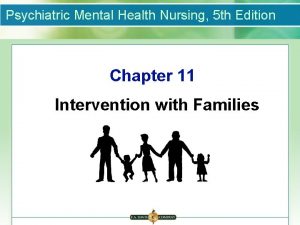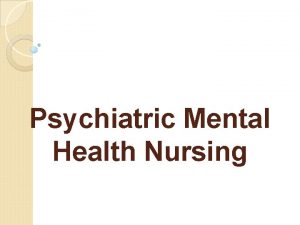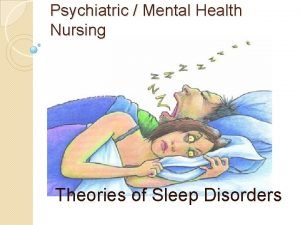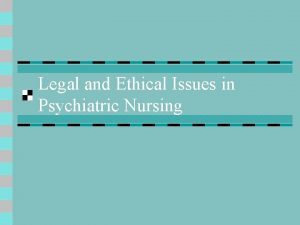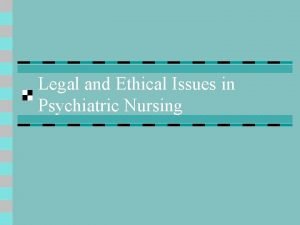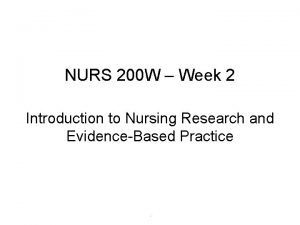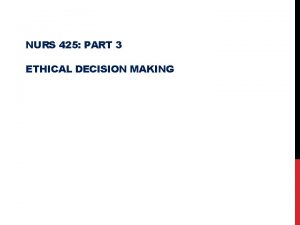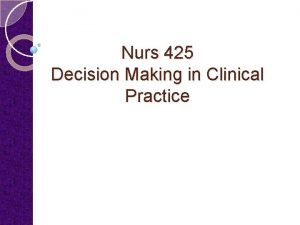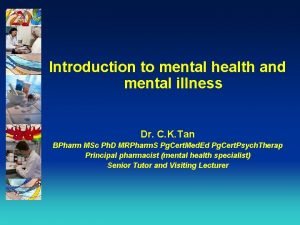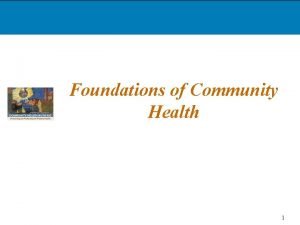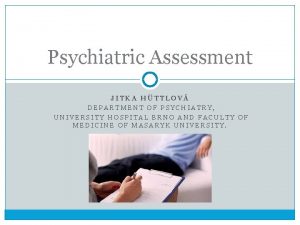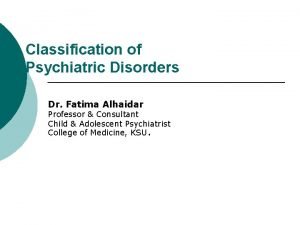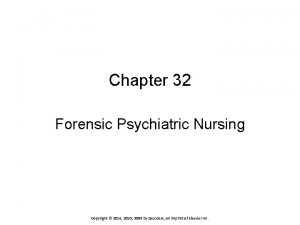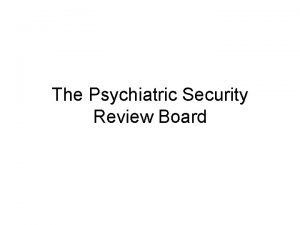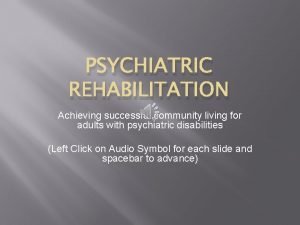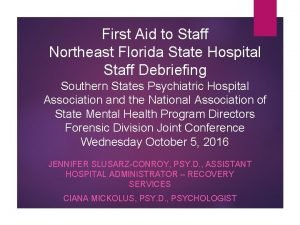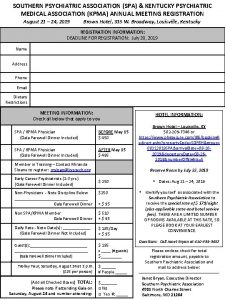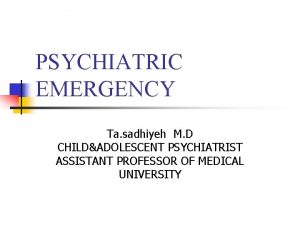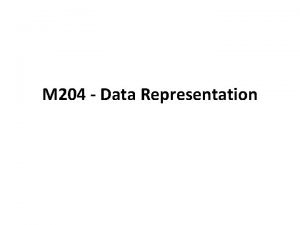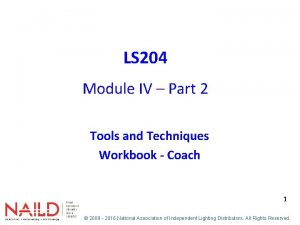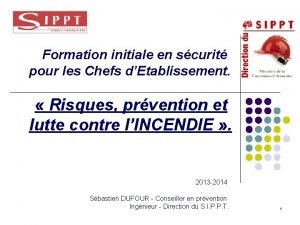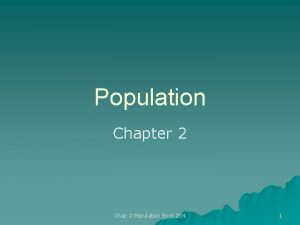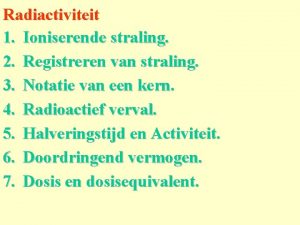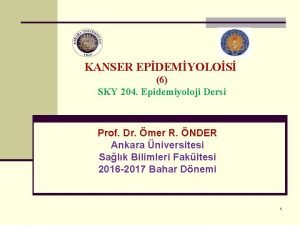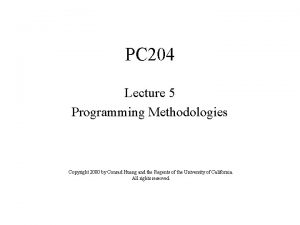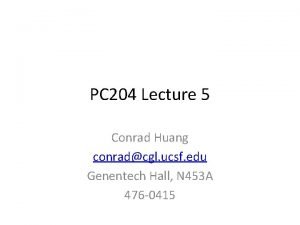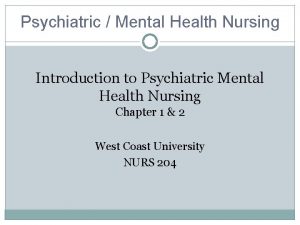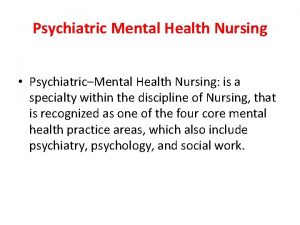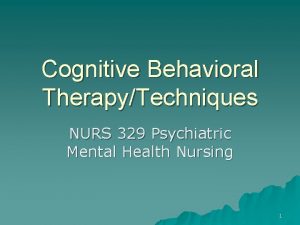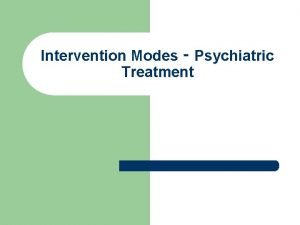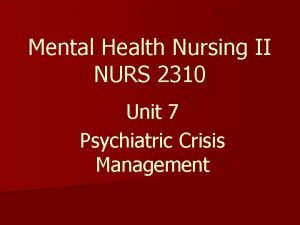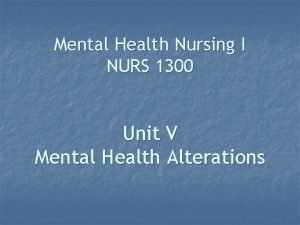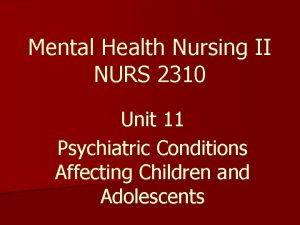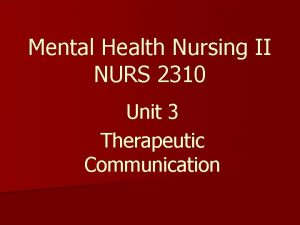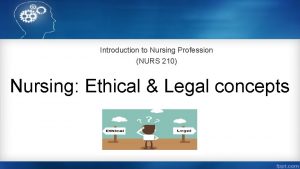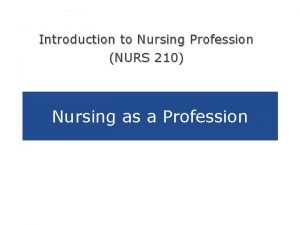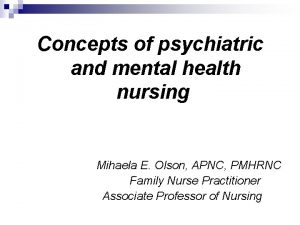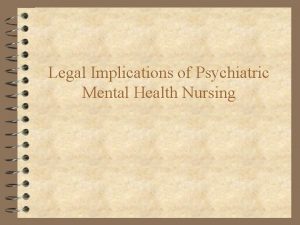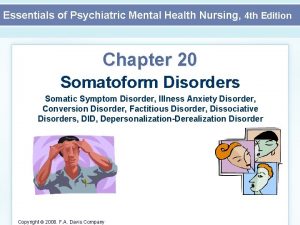NURS 204 Psychiatric Mental Health Nursing Introduction to























































- Slides: 55

NURS 204 Psychiatric / Mental Health Nursing Introduction to Psychiatric / Mental Health Nursing Philosophy and Theories for Interdisciplinary Psychiatric Care Chapter 1, 2 & 5 West Coast University

Caring for Psychiatric Mental Health Clients Feelings, Concerns, Questions—What Are They?

Factors Influencing Expectations Media Other? Upbringing Expectations Culture Life experiences

Psychiatric Mental Health Clients Psychiatric mental health clients are everyday, ordinary people.

Factors Impacting Mental Health and Mental Illness Biological Mental Illness or Mental Health Social Cultural

Mental Disorder Characteristics Distress Disability Risk

DSM-IV-TR Identifies Standardizes Categorizes

What do these terms mean? Crazy? Berserk? Weird? Wacky? Insane? Lunacy? Nervous Breakdown? Melancholy?

History Understanding and approaches to “madness” throughout history were influenced by: Social attitudes Philosophic viewpoints

Historical Approaches Era of Magico-Religious Explanations Era of Organic Explanations Era of Alienation Era of Confinement Era of Moral Treatment Reform leaders: William Cullen Philippe Pinel William Tuke Benjamin Franklin Benjamin Rush “Father of American Psychiatry”

A ward in Bethlehem Hospital about 1745. A patient is being chained in the foreground, and in the background are two Sunday visitors on an entertainment outing. Source: Philosophical Library.

Historical Approaches continued Era of Psychoanalysis Sigmund Freud Contemporary Developments Social dimensions Brain dysfunction Neurochemical Medication therapy

21 st Century Research Bases for mental disorders Psychotropic medications Role of nutrients, biology, and genetics

Mental Disorder Statistics High incidence with physical illness Account for 47% of all disability in economically developed countries Account for 28% of all disability worldwide

Prevalence Rates for Various Mental Disorders

Leading Causes of Mental Disability Worldwide

Mental Health Studies Epidemiologic Catchment Area (ECA) Global Burden of Disease (WHO) U. S. Surgeon General’s Report Healthy People 2010

Healthy People 2010 Adolescent suicide rate Homeless adults with serious mental illness (SMI) Relapse with eating disorders Mental health screening Treatment issues: Children and adults

Healthy People 2010 - continued Screening in juvenile justice Jail diversion programs for SMI Cultural competence issues Services for older adults: crisis intervention, screening, treatment Employee stress in the workplace

Psychiatric-Mental Health Nurses What do they do? Chapter 2

Psychiatric-Mental Health Nurses - continued Psychiatric-mental health nursing promotes mental health through: Assessment, diagnosis, and treatment of human responses to mental health problems and psychiatric disorders (ANA, APNA, ISPN, 2007)

Standards of Psychiatric-Mental Health Nursing Practice: Guidelines for providing quality care Psychiatric-Mental Health Nursing Standards of Practice 1. 2. 3. 4. Assessment Diagnosis Outcomes Identification Planning

Standards - continued Psychiatric-Mental Health Nursing Standards of Practice 5. Implementation A. Coordination of Care B. Health Teaching and Health Promotion C. Milieu Therapy D. Phamacological, Biological, and Integrative Therapies E. Prescriptive Authority and Treatment (APRN only) F. Psychotherapy (APRN only) G. Consultation (APRN only) 6. Evaluation

Psychiatric–Mental Health Nursing Standards of Practice

Standards - continued Standards of Professional Performance Quality of Practice 8. Education 9. Professional Practice Evaluation 10. Collegiality 11. Collaboration 12. Ethics 13. Research 14. Resource Utilization 15. Leadership 7.

Psychiatric–Mental Health Nursing Standards of Professional Performance

Psychiatric-Mental Health Nurses Generalist level Advanced practice level Prescriptive authority Psychotherapy Consultation

Estimated Number of Mental Health Workers in the United States

The Mental Health Team

Effective Mental Health Services Client Partnerships PMH Team Family

Lessons on Collaboration “Know thyself” Value diversity Know that conflict is natural Share your power with others Master communication skills Think life-long learning. Embrace interdisciplinary situations. Appreciate spontaneity. Balance unity with autonomy.

The Role of the Psychiatric-Mental Health Nurse Custodial Multifaceted

Early Psychiatric-Mental Health Nursing (19 th century) First school of nursing Florence Nightingale’s thoughts American nursing schools “First American psychiatric nurse” Single-focused training schools Custodial, mechanistic, directed by psychiatrists

Psychiatric-Mental Health Nursing (1900 -1940) Psychiatric nursing curricula Psychiatric nursing texts Single-focus psychiatric nursing schools

Psychiatric-Mental Health Nursing (1940 -1990) Nurses begin to educate nurses. Psychiatric theory includes interpersonal and emotional dimensions. National Mental Health Act of 1946 Elimination of single-focus psychiatric nursing schools Period of role clarification Hildegard Peplau Gwen Tudor Frances Sleeper Community Mental Health Centers Act of 1963 Psychiatric nursing journals

Psychiatric-Mental Health Nursing (1940 -1990) continued Birth of clinical nurse specialists and nurse therapist role First standards of psychiatric-mental health nursing practice Increase role of nurses at national level Shift in psychiatric nursing toward humanistic interactionism Decrease in numbers of psychiatric nurses Decreased funding for training Psychiatric nursing diagnoses

Psychiatric-Mental Health Nursing (1990 s) Decade of the Brain Psychobiologic concepts Nursing Psychopharmacology Project Health care delivery reform Outcome-based research Cultural diversity Integration of theoretical perspectives

Psychiatric-Mental Health Nursing (2000 s) - The New Millennium Standards of practice – revisions Knowledge explosion Renewed focus on physical health Single point of entry Advanced practice nurses Expansion of practice settings

Nursing Theories Assist nurses to: Organize assessment data Identify problems Plan interventions Generate goals and actions Evaluate outcomes

Nursing Theories Impacting Psychiatric Nursing Marjory Gordon – Functional Health Patterns (1987) Hildegard Peplau – Interpersonal Relationships (1952) Dorothea Orem – Self-Care Deficit (1959) Dorothy Johnson – Behavioral System (1968) Sister Callista Roy – Adaptation Model (1976)

Nursing Theories - Value Nursing practice vs. medical practice Caring vs. curing Interpretation of meaning Nurse-client relationship Advocacy of client dignity Advocacy of nurse authenticity

Application of Theoretical Frameworks Application of various theoretical frameworks leads to: Quality client-centered care. Efficient use of resources. Practice-oriented research. Clinical judgments and actions that can be articulated and taught to others.

Gordon's 11 Functional Health Patterns Functional Health Pattern Describes Examples Health Perception/ Health Management Client's perceived pattern of health and well-being and how health is managed. Compliance with medication regimen, use of health-promotion activities such as regular exercise, annual check-ups. Nutritional-Metabolic Pattern of food and fluid consumption relative to metabolic need and pattern; indicators of local nutrient supply. Condition of skin, teeth, hair, nails, mucous membranes; height and weight. Elimination Patterns of excretory function (bowel, bladder, and skin). Includes client's perception of Anormal" function. Frequency of bowel movements, voiding pattern, pain on urination, appearance of urine and stool. Activity - Exercise Patterns of exercise, activity, leisure, and recreation. Exercise, hobbies. May include cardiovascular and respiratory status, mobility, and activities of daily living. Cognitive-Perceptual Sensory-perceptual and cognitive patterns. Vision, hearing, taste, touch, smell, pain perception and management; cognitive functions such as language, memory, and decision making. Sleep-Rest Patterns of sleep, rest, and relaxation. Client's perception of quality and quantity of sleep and energy, sleep aids, routines client uses.

Gordon's 11 Functional Health Patterns Functional Health Pattern Describes Examples Role-Relationship Client's pattern of role engagements and relationships. Perception of current major roles sand responsibilities (e. g. , father, husband, salesman); satisfaction with family, work, or social relationships. Sexuality-Reproductive Patterns of satisfaction and dissatisfaction with sexuality pattern; reproductive pattern. Number and histories of pregnancy and childbirth; difficulties with sexual functioning; satisfaction with sexual relationship. Coping / Stress Tolerance General coping pattern and effective of the pattern in terms of stress tolerance. Client's usual manner of handling stress, available support systems, perceived ability to control or manage situations. Value - Belief Patterns of values, beliefs (including spiritual), and goals that guide client's choices or decisions. Religious affiliation, what client perceives as important in life, valuebelief conflicts related to health, special religious practices. Self-Perception/ Self Concept Client's self-concept pattern and perceptions of self. Body comfort, body image, feeling state, attitudes about self, perception of abilities, objective data such as body posture, eye contact, voice tone.

Holistic Practice: Expanded Role for Nurses (Chapter 5) Interactionism Individuals have purpose and control. Humanistic cast Interaction of psychology, psychobiology, and sociocultural contexts Humanism Devotion to individual interests Spirit of compassion and caring Affirming of the joy, beauty, and value of living

Nursing Implications Humanistic Interactionism Interrelated physical and mental factors Holistic Expanded role for psychiatric-mental health nurses Client and family role includes negotiation and advocacy.

Nursing Implication Psychobiology Focus on biological, medical, and human aspects of care. Holistic Integrative New knowledge “High tech” and “high touch” Nature and nurture Biologic sciences and behavioral sciences

Medical-Psychobiologic Theory Key concepts Emotional disturbance indicates illness or defect. Illnesses are located in the brain or central nervous system. Illnesses have specific characteristics. Mental diseases have a characteristic course. Mental disorders respond to physical or somatic treatments. Psychobiologic explanations reduce stigma.

Psychoanalytic Theory Sigmund Freud: All psychological emotional events can be understood. Childhood experiences → adult neuroses Goal of therapy is gaining insight.

Psychoanalytic Theory Levels of awareness in relation to id, ego, and superego

Cognitive Concepts

Social–Interpersonal Theories

Social–Interpersonal Theories

Maslow: Self-Actualization and Hierarchy of Needs

Comparison of Traditional Psychiatric Theories
 Chapter 11 psychiatric mental health nursin
Chapter 11 psychiatric mental health nursin Conclusion of nursing process
Conclusion of nursing process Nursing process in psychiatric nursing
Nursing process in psychiatric nursing Mental health nursing definition according to who
Mental health nursing definition according to who Development of modern psychiatric nursing
Development of modern psychiatric nursing Chronic insomnia
Chronic insomnia Legal issues in psychiatric nursing
Legal issues in psychiatric nursing Ethical issues in psychiatric nursing
Ethical issues in psychiatric nursing What is a good pico question
What is a good pico question Nurs 425
Nurs 425 Nurs 425
Nurs 425 Chapter 20 mental health and mental illness
Chapter 20 mental health and mental illness Mental illness mental health jeopardy
Mental illness mental health jeopardy Conclusion of community mental health nursing
Conclusion of community mental health nursing Titles for mental health presentations
Titles for mental health presentations Mental health introduction
Mental health introduction Component of community health nursing
Component of community health nursing Mse psych
Mse psych Psychological disorders
Psychological disorders Cmc psychiatric hospital
Cmc psychiatric hospital Role of psychiatric nurse
Role of psychiatric nurse During a psychiatric emergency the emt should be able to
During a psychiatric emergency the emt should be able to Psychiatric security review board
Psychiatric security review board Psychiatric rehabilitation
Psychiatric rehabilitation Psychiatric nurse conference
Psychiatric nurse conference American psychiatric association annual meeting 2020
American psychiatric association annual meeting 2020 Northeast florida state hospital
Northeast florida state hospital Psychiatric services liberty hill
Psychiatric services liberty hill Southern psychiatric association
Southern psychiatric association Psychiatric emergency
Psychiatric emergency Psychiatric emergency
Psychiatric emergency Szpv 204
Szpv 204 Nkb 7
Nkb 7 What is binary
What is binary Gloucester county health department
Gloucester county health department Ipsd 204 accelerated math
Ipsd 204 accelerated math Revised bp form 202 (2021 budget tier 2)
Revised bp form 202 (2021 budget tier 2) 204
204 Nbn en 671-1
Nbn en 671-1 Wordle 204 3/6
Wordle 204 3/6 204/90 simplified
204/90 simplified 5 centésimos en decimal
5 centésimos en decimal Cómo se escribe 15 enteros 204 milésimos
Cómo se escribe 15 enteros 204 milésimos On average 113 204 aluminum cans
On average 113 204 aluminum cans Tabel 25 binas
Tabel 25 binas Polonyum 204
Polonyum 204 Dossier machine
Dossier machine Far52.204-21
Far52.204-21 Easter island chile
Easter island chile Pc 204
Pc 204 Afi 31-201
Afi 31-201 Dfars 252 204 7012
Dfars 252 204 7012 Rdsn 80
Rdsn 80 Pc 204
Pc 204 Pc 204
Pc 204 Nkb 212
Nkb 212
